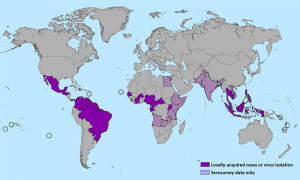Although it may be fun to say, the Zika Virus is no laughing matter.
According to the U.S. Centers for Disease Control and Prevention the number of Zika Virus infections has increased to 147 in recent months (only 107 of which are from international travelers from Zika-infected areas). Moreover 117 more cases of Zika were reported from Puerto Rico after the CDC released those aforementioned numbers. The CDC urges that people refrain from traveling to highly infected areas like Puerto Rico and especially Brazil for the 2016 Summer Olympics.
Zika is spread through the bite of an infected female mosquito (typically of the Aedis Aegipty type) and 80% of the infected showed a variety of the following symptoms: mild fever, skin rash around area of bite and other, conjunctivitis (pink eye), muscle and joint pain that last for approximately 1 week, and fatigue.
Now you may be asking yourself, “What’s so dangerous about a virus that sounds like it should be a Pokémon? People get over viruses every day?” Well the answer is not with Zika itself, but rather with what Zika causes.
Several studies have emerged that claim Zika is directly connected to Guillain-Barre Syndrome and Microcephaly. Additionally, the PAHO (Pan American Health Organization) claims there is no evidence that Zika can cause death, but there have been several reports of it worsening pre-existing medical conditions.

Areas of Zika Virus infection and density of cases (the darker the purple the more amounts of cases in that area)
Guillain-Barre Syndrome – an extremely rare disorder in which your body’s immune system attacks the nervous system, systematically destroying it over a long period of time. Although weakness and tingling to extremities are first symptoms, they can quickly spread eventually leading to full-body paralysis. Most people with the rare disease must be immediately hospitalized for rigorous treatment.
Microcephaly – a rare neurological condition in which an infant’s head is significantly smaller than average. Most often it can be detected at birth and sometimes avoided with late-stage abortions but recent U.S. laws have prevented such actions. Microcephaly results in abnormally low brain function and development (not growing enough in the womb and not developing at a normal pace after birth.) Children with Microcephaly have severe developmental issues and there is no treatment or cure.
Microcephaly can be caused by Zika if a woman contracts the virus in the first and second trimester of the pregnancy. 9 cases of pregnant women contracting Zika have been recorded and of those 9 cases, two women had miscarriages, two women terminated their pregnancies, one woman had a baby with very severe Microcephaly, and most other women contracted the virus in the late stages of the pregnancy and had generally healthy babies
In conclusion, if you are a pregnant woman try not to travel to exotic and/or tropical areas where Zika-infected mosquitos usually live.




Leukemia
Benadryl, great article! You define well the dangers and recent developments on the Zika virus, and why it is of concern. I heard an interesting NPR broadcast from Feb. 11, 2016 that discussed with current researchers at Washington University in St. Louis and University of Texas Medical Center in Galveston whom are working closely to recreate the disease into model organisms (like mice) to study the virus’ effects and possible treatments. Previously, few laboratories studied the virus because it did not attract much attention. Now, however, the virus on center stage has captivated the global audience; new research grants for the disease are numerous and laboratories are now scrambling to study the pathology and epidemiology of the disease. The news broadcast describes the processes different research labs employ to understand the disease, efficiently diagnose the disease, and develop a treatment for the disease. Especially in the case of a disease that, although not novel, is poorly understood, the process of researching and studying a disease becomes trying and obscure. I am left questioning what role the genetic structures of the disease have played in becoming a rapid breakout that has explosively arisen from insignificance.
The broadcast can be found here: http://www.npr.org/player/v2/mediaPlayer.html?action=1&t=1&islist=false&id=466015517&m=466186366